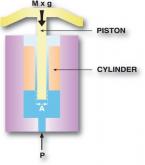- Other Fluke companies:
- Fluke
- Fluke Biomedical
- Fluke Networks
- Fluke Process Instruments
How a pressure balance works
Pressure is fundamental
How a pressure balance works
The floating piston
Deadweight tester assumptions
The type of pressure balance commonly used in industry is called a deadweight tester. Deadweight testers define pressure based on a couple of assumptions. The two big ones are:
The gravity of the situation
Many people don’t realize that standard international gravity is defined at 45 degrees latitude north or south of the equator at sea level. It has a value of 9.80665 m/s2. Phoenix Arizona is closer to the equator than 45 degrees latitude, and the value of local gravity is 9.79474 m/s2. The difference is more than 1200 ppm (0.12%)! An industrial deadweight tester is typically specified to around 150 ppm, and with quality hardware and the right corrections you can even do much better than that. But if you fail to take into account local gravity, you don’t stand a chance.
- Login to post comments
- Printer-friendly version »
- Home
- Products
- New Products
- Electrical Calibration
- RF Calibration
- Data Acquisition and Test Equipment
- Temperature Calibration
- Humidity Calibration
- Pressure Calibration
- Flow Calibration
- Process Calibration Tools
- Calibration Software
- Service and Support
- All Calibration Instruments
- Handheld Test Tools
- Purchase Info
- News
- Training and Events
- Literature and Education
- Service and Support
- About Us



